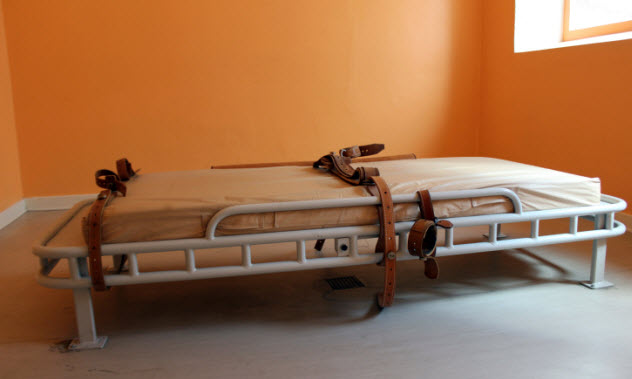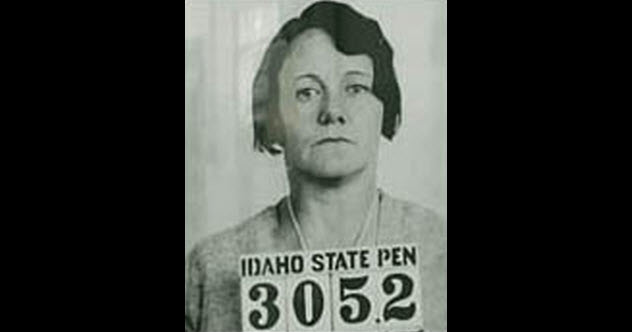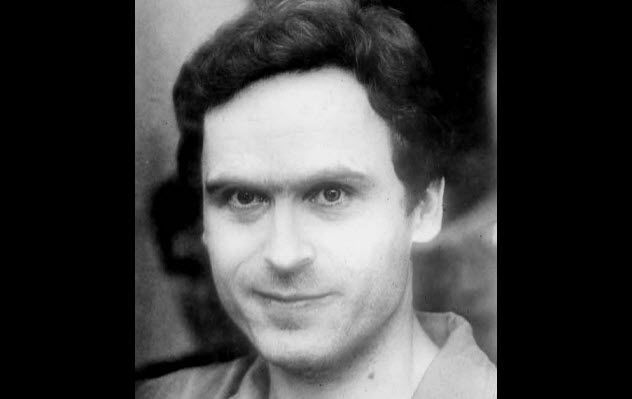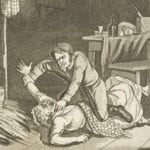 Weird Stuff
Weird Stuff  Weird Stuff
Weird Stuff  Mysteries
Mysteries 10 Tragic Disappearances and Deaths in Joshua Tree National Park
 History
History 10 Ways Childhood Really Sucked in the Old West
 Music
Music 10 Name Origins of Famous Bands from the 1990s
 Religion
Religion 10 Biggest Turnarounds by the Catholic Church
 Weird Stuff
Weird Stuff 10 Unbelievable Times Laws Had Unintended Consequences
 Humans
Humans Ten Historic Women Who Deserve Way More Credit Than They Got
 Movies and TV
Movies and TV 10 Films That Spawned Major Lawsuits
 History
History Ten Times Towns Were Wiped Off the Face of the Earth
 Creepy
Creepy 10 of the Most Disturbingly Haunted Public Houses in the UK
 Weird Stuff
Weird Stuff 10 Niche Subcultures That Are More Popular Than You Might Think
 Mysteries
Mysteries 10 Tragic Disappearances and Deaths in Joshua Tree National Park
 History
History 10 Ways Childhood Really Sucked in the Old West
Who's Behind Listverse?

Jamie Frater
Head Editor
Jamie founded Listverse due to an insatiable desire to share fascinating, obscure, and bizarre facts. He has been a guest speaker on numerous national radio and television stations and is a five time published author.
More About Us Music
Music 10 Name Origins of Famous Bands from the 1990s
 Religion
Religion 10 Biggest Turnarounds by the Catholic Church
 Weird Stuff
Weird Stuff 10 Unbelievable Times Laws Had Unintended Consequences
 Humans
Humans Ten Historic Women Who Deserve Way More Credit Than They Got
 Movies and TV
Movies and TV 10 Films That Spawned Major Lawsuits
 History
History Ten Times Towns Were Wiped Off the Face of the Earth
 Creepy
Creepy 10 of the Most Disturbingly Haunted Public Houses in the UK
10 Serial Killers Who Escaped From Custody
Murder is easily one of the most terrifying crimes that one human can commit against another. So it’s understandable that murderers should be securely locked away in prison. Yet sometimes these people do get out. And while not all of them were serial killers before they broke out, they certainly were by the time they were recaptured.
10 Richard Caputo

In 1971, Richard Caputo stabbed his girlfriend, Natalie Brown, to death. After he was arrested, it was ruled that he wasn’t mentally competent to stand trial. He was committed to a mental institution where he started a relationship with one of his psychologists, a woman named Judith Becker. Eventually, Caputo was transferred to a minimum-security mental institution where he was given furloughs. On one of those furloughs in October 1974, he strangled Becker and left New York City.
In 1975, Caputo found a new lover in San Francisco. But sadly, her battered body was found later in her apartment. After that, he fled to Mexico City, where he killed his fourth victim in 1977.
Over the next 20 years, Caputo avoided capture, going back and forth from the US to Mexico three times. One time, just before the murder of his fourth victim, he was held at the El Paso border but managed to escape. Eventually, he married a woman and had children with her. He left that family and married another woman, with whom he also had children. Meanwhile, the search for him continued. He was even featured on America’s Most Wanted.
Then, on January 18, 1994, Caputo turned himself in because he was racked with guilt. He confessed to four murders, and police believe that he was responsible for two additional kills as well. Caputo’s lawyers argued that he suffered from multiple personalities, so he wasn’t responsible for the murders. The judge didn’t buy it. Caputo was found guilty and sentenced to 8.5 to 25 years in prison. He died about two years into his sentence in October 1997.
9 Donald Leroy Evans

In 1991, avowed white supremacist Donald Leroy Evans was arrested for the rape and murder of a 10-year-old homeless girl, whom he had kidnapped from Mississippi. Once in custody, Evans bragged about other murders he had committed over the years. He claimed he had killed over 70 people in a number of states, so task forces were started to look for the bodies. In the end, Evans was probably responsible for three murders, that of the 10-year-old girl and two prostitutes in Florida in 1985. Out of those crimes, he was charged with two murders.
On June 13, 1993, while awaiting trial, Evans and three other inmates overpowered a guard at the Harrison County Jail in Mississippi. By threatening the guard with a shank, the four men were able to flee from the prison.
Immediately, authorities set up roadblocks and brought out dogs to search for the fugitives. They worried that New Orleans wasn’t far from the jail, and Evans might be able to hide out in the large tourist city. Luckily for everyone, Evans was found after only about 24 hours on the lam. He was hiding in a shed in a lumber yard about 800 meters (0.5 mi) from the prison.
Just months after being recaptured, Evans pleaded guilty to murder and was sentenced to death. In 1999, Evans was stabbed to death in prison by a fellow death row inmate as he was being led back from the showers.
8 Rodney Halbower

On the day after Christmas in 1975, Rodney Halbower was released on bail pending his trial for raping a blackjack dealer in Nevada. Over the next five months, Halbower raped and murdered at least six women—five in the San Francisco Bay area and one in Reno. After the killing spree, he went back to Nevada to stand trial and was given a life sentence for rape.
With Halbower locked up in a different state, the cases of the five victims in the San Francisco area went cold. They became known as the “Gypsy Hill” murders. While the murder in Reno had been pinned on a mentally ill woman, who was confined to a mental institution for the crime, mounting evidence suggested that she was innocent.
But Halbower wasn’t locked up tight enough in prison because he was able to escape twice. The first time happened during a softball game in June 1977. He made it all the way to Michigan, where he kidnapped his own daughter.
The second time was in December 1986. He and another inmate—also a sex offender—climbed a wall, cut holes in two fences, and ran under a guard tower. A short time later, he was in Medford, Oregon, where he stabbed a 23-year-old woman 19 times while trying to steal her purse. Luckily, she survived the attack. Halbower was convicted of the attempted murder in Oregon and sent back to prison in Carson City.
When Halbower was paroled in 2013 for the original rape charge, he was sent directly to Oregon to serve his sentence. There, he had a DNA sample taken. It matched samples from the Gypsy Hill murders and the murder in Reno. Halbower’s escape was the reason that he was connected to the murders. If he hadn’t gone to Oregon, his DNA test might not have been done. In early 2015, Halbower was charged with two of the six murders.
7 Bartolomeo Gagliano

Italian serial killer Bartolomeo Gagliano got his start in 1981, when he beat a 29-year-old prostitute to death with a rock. He was arrested and sentenced to eight years in a mental institution. In 1983, he escaped and took a family hostage. He was recaptured after a shoot-out with the police.
In early 1989, Gagliano and another patient broke out of an asylum and shot two people to death. In February, they shot transsexual Nahir Fernandez Rodriguez in the mouth. Then on Valentine’s Day, they shot transvestite and drug addict Francesco Panizzi. A few days after that, they shot prostitute Laura Baldi in the face and the neck, but she miraculously survived. The pair was captured shortly afterward. Again, Gagliano was committed to an asylum. This time, he served his time for the three murders and was released.
In 2010, Gagliano was back in prison for extortion. Officials there claimed they weren’t aware of Gagliano’s murderous past and thought he was just a thief. By acting like a model prisoner, Gagliano got a day pass to visit his mother in the hospital. Once outside, he hijacked a car and kidnapped the man inside. Gagliano was arrested three days later in France near the Italian border.
Gagliano was given six years and 10 months for crimes committed while on the lam. On January 22, 2015, he committed suicide by hanging himself with his bedsheet in prison.
6 Allan Legere

In 1979, Allan Legere was being held for two violent acts in bars in the Miramichi area of New Brunswick, Canada. While being held, he escaped from prison. Recaptured in a different province, he was brought back to face trial. Eventually, he was convicted and served his time.
On June 21, 1986, 38-year-old Legere and two accomplices in their late teens broke into the house of 66-year-old John and 61-year-old Mary Glendenning to steal a safe. The couple was brutally beaten, and Mary was sexually assaulted. The assault left John dead, and the trio was arrested and convicted.
Legere was given a life sentence. In May 1989, while being transferred to a medical appointment, Legere escaped from custody. He eluded capture for months, even though he sneaked into communities along the Miramichi River.
Twenty-five days after escaping, Legere murdered 75-year-old Annie Flam. Five months later, he murdered a pair of sisters, 45-year-old Donna and 41-year-old Linda Daughney. Finally, five weeks later, he murdered a 69-year-old Catholic priest named James Smith. Each of the victims had been tortured for hours before their deaths.
In November 1989, nine days after the murder of Smith, Legere was recaptured. He’d been on the loose for 201 days. He was convicted of all four murders and is currently being held in a minimum-security prison in Edmonton, Alberta.
5 Earle Nelson

Born May 12, 1897, in San Francisco, California, Earle Nelson grew up in a strict religious family. He also suffered a terrible head injury that left him unconscious for six days. After the incident, he appeared to recover, but Nelson grew up to become a troubled man.
In May 1918, he was arrested for trying to molest a young girl and placed in a mental institution. However, he kept escaping. While he was on the lam, the hospital simply discharged him, so they didn’t have to put resources into continually catching him. A few years later, he was committed again for threatening the wife whom he married after escaping. In May 1925, Nelson escaped once more. Still, hospital officials didn’t go after him.
A few months after escaping, Nelson traveled all the way to Philadelphia, where he went on a two-year murder spree that claimed 26 victims. Most of the time, he targeted landladies by pretending to be a renter. Once he had the women alone, he strangled them and performed necrophilia on the bodies. He also stole items from the victims and pawned them. Using that as his only income, Nelson hitchhiked across the US, killing women in Stockton, Portland, Seattle, Council Bluffs, Kansas City, Buffalo, Detroit, and Chicago.
After killing a woman in Chicago, Nelson hitchhiked into Winnipeg, Manitoba, Canada, where he murdered yet another woman and a 14-year-old girl. After a store owner recognized Nelson near the small town of Wapoka, Manitoba, he was arrested heading toward the US border.
Taken to the town’s small police department, he was placed in a cell. When the town’s only police officer left to call Winnipeg, Nelson searched the cell, found a rusty nail, and used it to break out. He fled to the train station, where he hopped on the first train heading south.
However, Nelson had boarded a train carrying a number of Winnipeg detectives who recognized him. He was rearrested, convicted of one murder, and sentenced to death. Nelson, also known as the “Gorilla Killer,” was hanged on January 13, 1928, in Winnipeg.
4 Lyda Trueblood

Lyda (aka “Lydia”) Trueblood was first married in 1912. She and her husband settled in Twin Falls, Idaho, and had a daughter named Lorraine. While living there, a terrible sickness descended on the house. First, Lyda’s brother-in-law, with whom the young family lived, got sick and passed away. Not long after his death, Lorraine mysteriously got sick and died in 1915. A short time later, Lyda’s husband also was stricken and died.
Lyda remarried two years later. A few months after their first wedding anniversary, that husband also got sick and died. Then, in both 1919 and 1920, she married again. Neither man survived more than a few months of married life.
Finally, the police suspected that Lyda’s four husbands, child, and brother-in-law did not die natural deaths. They did a blood test on the fourth husband and exhumed the bodies of Lyda’s three other husbands and daughter. After finding traces of arsenic in their bodies, the police went to arrest Lyda. But she was gone. Having escaped to California, she had married another man and was trying to convince him to get a life insurance policy.
She was arrested, convicted, and sentenced to life.
After about 10 years, Trueblood settled into a routine. She didn’t cause much trouble, so the prison relaxed the rules for her. Taking advantage of the lax security, Trueblood knocked a bar out of her cell window. With a rope made from bedsheets, she climbed out of her cell and scaled a wall. Waiting for her outside was David Minton, with whom she had a relationship. He had been paroled from the prison three months earlier.
While on the lam, she left Minton and married her sixth husband, whom she was trying to convince to get life insurance. She was recaptured after fifteen months on the lam, and her sixth marriage was annulled. In October 1941, Trueblood was released to her sister’s home. She married again, but the man’s children wouldn’t allow Trueblood to see their father. She died in Utah in February 1958.
3 Jaishankar

On August 23, 2009, while on duty, police constable M Jayamani was kidnapped from the Kangeyam district in India. When her body was found on September 19, a massive manhunt was launched for the killer. A month later, they arrested a man named Jaishankar and charged him with the murder. Authorities also connected him to 13 other rape-murders and six more rapes.
On March 18, 2011, after going to court, Jaishankar was being transported from Coimbatore to Dharmapuri when he escaped in Salem at a bus depot. The day after his escape, one of the guards committed suicide over the incident. Over the next two months, it’s believed that Jaishankar raped and murdered six women, plus he killed a man and a child. Jaishankar was recaptured after he tried to sexually assault a woman, who had called for help.
In April 2013, Jaishankar was convicted of rape and sentenced to 10 years. As he was serving his sentence in Parappana Agrahara Central Prison, he planned his next escape. On September 2, 2013, he used a duplicate key to get out of his cell. Then he climbed a 6-meter (20 ft) fence, walked across a roof, and climbed a 9-meter (30 ft) wall.
Using either a belt or a bedsheet to lower himself down the wall, he fell and hurt himself during the escape. Four days later, he was recaptured. Fortunately, no one else was killed. Jaishankar was returned to prison and is facing 20 other charges of murder.
2 Randy Greenawalt

In 1974, Randy Greenawalt was sentenced to life for murdering a truck driver. As the trucker slept in his cab, Greenawalt drew an “X” on the window of the vehicle and fired a bullet through it. He also admitted to killing two other men, another trucker in Arkansas, and a man in Colorado. He was sent to the Arizona State Prison.
While doing his time, he met Gary Tison, who was also serving a life sentence. While trying to escape, Tison had killed a corrections officer who was transporting him to a Florida prison.
In late July 1978, Tison and Greenawalt were being held in the minimum-security area of the prison. On July 30, under the pretense of a visit, three of Tison’s sons sneaked shotguns and handguns into the prison in a cooler. After locking the guards in a closet, Tison and Greenawalt dressed in civilian clothes, calmly walked to their car, and drove away.
Their escape wasn’t without its hitches, though. At one point, they got two flat tires, so they flagged down a passing car. Inside the car was 24-year-old John Lyons, his 23-year-old wife Donnelda, their two-year-old son Christopher, and the couple’s 15-year-old niece Teresa Tyson. The five criminals forced their innocent victims into the car with the flat tires and drove them to the desert. There, Tison and Greenawalt opened fire with the shotguns. The bodies of John, Donnelda, and Christopher were found on August 6. Five days later, Teresa’s body was found a short distance away.
Later, while they were stuck in traffic in Colorado, Greenawalt and the four Tisons saw a van that suited them better. They forced their way into the van and killed the newly married couple inside. The bodies of 26-year-old James Judge and 23-year-old Margene Judge were found partially buried a few months later.
On August 11, the gang was stopped by a police roadblock. Tison’s oldest son, who was driving the van, was shot in the head when he tried to ram a second barricade. Tison, his remaining two sons, and Greenawalt ran into the desert. Everyone but Tison was arrested. Tison died of dehydration in the desert.
Greenawalt and the two surviving Tisons were sentenced to death. The Tisons had their sentences commuted to life, but Greenawalt was executed on January 23, 1997, for the six murders he helped to commit during the gang’s 12 days on the lam.
1 Ted Bundy

In August 1975, nefarious serial killer Ted Bundy was first arrested for kidnapping after one of his victims escaped and gave police a description of his Volkswagen Beetle. Bundy was convicted of the kidnapping in 1977 and given a 15-year sentence.
However, prosecutors were still pursuing murder charges against him. In June 1977 in Aspen, Colorado, Bundy was alone in a court library preparing his defense when he found an open window. He jumped from the second story, walked down Main Street, and disappeared. With authorities swarming around Aspen, Bundy was captured six days later. Luckily, he didn’t kill anyone on that escape.
Unfortunately, that wasn’t the only time he escaped. On December 31, 1977, Bundy, who had lost 15 kilograms (30 lb), was able to slip through a hole he had cut in the ceiling of his cell in the Glenwood Springs’ jail. Prison officials didn’t realize Bundy was gone until 15 hours later. That gave Bundy the time he needed to make his way to Tallahassee, Florida.
On January 14, 1978, Bundy broke into a Florida State University sorority house and beat four women sleeping there, killing two and seriously injuring a third. Hours later, he broke into another house where he beat dance student Cheryl Thomas almost to death. Her neighbors heard the commotion and called police. Aware of what happened at the sorority house, police arrived within four minutes, but Bundy was gone.
In February 1978, Bundy made his way to Lake City, Florida, where he kidnapped 12-year-old Kimberly Leach from her school. The next day, Bundy was put on the FBI’s Ten Most Wanted Fugitives list. But Kimberly’s body wasn’t found until two months later.
On February 15, Bundy was arrested while driving a stolen Volkswagen Beetle in Pensacola, Florida. Ultimately convicted of the murders he committed while on the lam, Bundy was given the death sentence. He admitted to a total of 30 murders, but it’s believed that he committed more. Bundy was executed on January 24, 1989.
Robert Grimminck is a Canadian freelance writer. You can friend him on Facebook, follow him on Twitter, or visit his website.

![10 Creepiest Photos Of Victims Taken By Serial Killers [DISTURBING] 10 Creepiest Photos Of Victims Taken By Serial Killers [DISTURBING]](https://listverse.com/wp-content/uploads/2018/09/Regina-Kay-Walters-featured-2-150x150.jpg)






